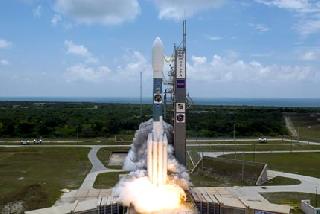
Delta II rocket. Photo: NASA/Jerry Cannon, Robert Murray
WASHINGTON (AFP): Sea level rise is threatening the majority of NASA's launch pads and multi-billion dollar complexes famous for training astronauts and launching historic missions to space, scientists said.
From Cape Canaveral in Florida to mission control in Houston, the US space agency is busily building seawalls where possible and moving some buildings further inland.
Five of seven major NASA centres are located along the coast. Experts say that proximity to water is necessary for safety and logistics when launching rockets and testing spacecraft.
Many NASA centres have already faced costly damage from encroaching water, coastal erosion and potent hurricanes, said a report on Tuesday by the Union of Concerned Scientists.
Perhaps the most iconic launchpad lies in Florida at the Kennedy Space Centre, the liftoff point for the Apollo missions to the Moon and many space shuttle flights over the past three decades.
"According to NASA's planning and development office, rising sea levels are the single largest threat to the Kennedy Space Centre's continued operations," said the report, which also listed various historic sites across the United States that also are threatened by sea level rise.
They include the Statue of Liberty in New York, the first permanent British colony in North America at Jamestown Island in Virginia, and historic Charleston, South Carolina.
One key NASA site that is succumbing to rising seas is Wallops Flight Facility in Virginia, where 16,000 rockets have launched and where sea level has surged nine inches since it opened in 1945.
 Previous Article
Previous Article Next Article
Next Article









The Indian Air Force, in its flight trials evaluation report submitted before the Defence Ministry l..
view articleAn insight into the Medium Multi-Role Combat Aircraft competition...
view articleSky enthusiasts can now spot the International Space Station (ISS) commanded by Indian-American astr..
view article